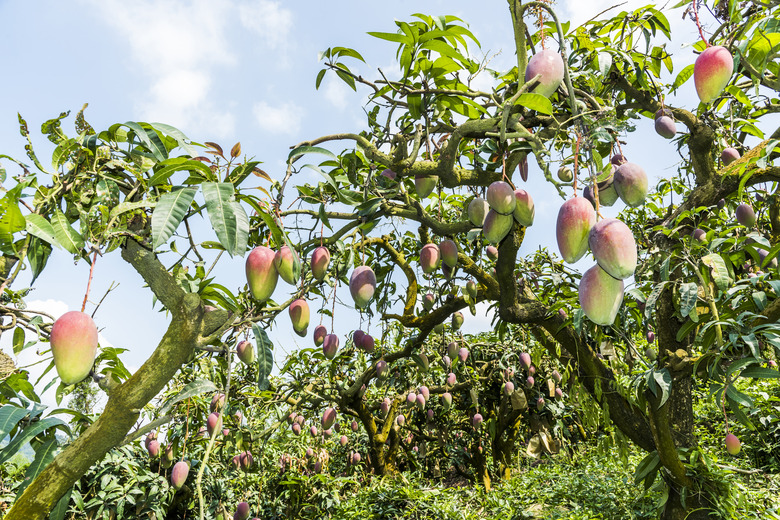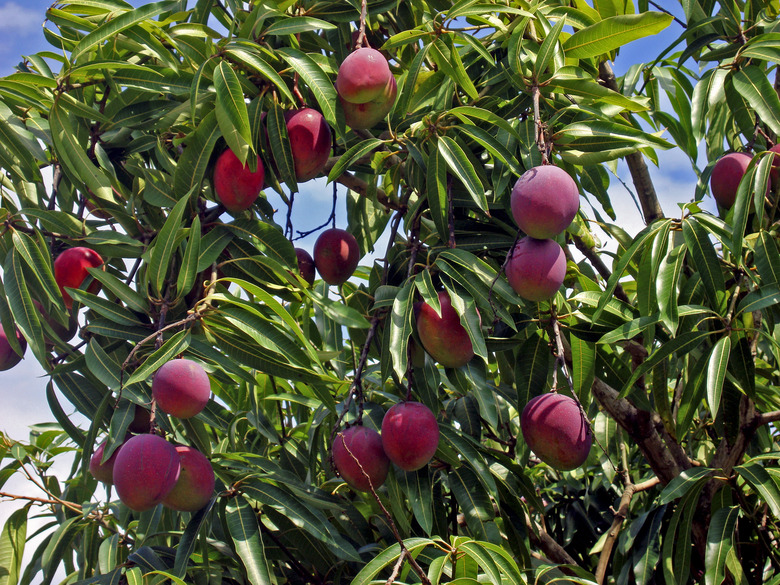How To Grow Mangoes
With a taste described as peach meets apricot meets papaya, mangoes (Mangifera indica, USDA plant hardiness zones 11-12) are a sweet indulgence that many enjoy. You can eat the versatile mango raw right off the tree, add it to chutneys and other dishes, bake it into tarts and cakes, or puree it to form the base of sherbets, ice creams, drinks, and sauces.
There are more than 500 different cultivars of mangoes, but all are plants that grow in tropical climates and don't function well in areas where the temperature drops below 40 degrees Fahrenheit. If you're lucky enough to live where they grow, a single mature tree can produce 100 to 200 pounds of fruit in a single season, so you'll never have to do without.
Best Uses for Mangoes
Mango trees are evergreen trees with shiny, broad leaves that start life in hues of pink and light green before changing to a deeper green at maturity. In the spring, these fruit trees sprout thousands of tiny pink flowers that are both beautiful and pleasantly fragrant. This makes the trees somewhat decorative, and their massive size can make a bold statement. At maturity, some mango varieties grow more than 100 feet tall and 45 feet wide.
Although they're pretty trees, most gardeners plant mango trees for their tasty fruit rather than their good looks. To that end, the most popular mango cultivar is the dwarf Tommy Atkins (Mangifera indica 'Tommy Atkins'). This cultivar produces well and only grows 10 to 15 feet tall, making it a good fit for most home landscapes.
Mango trees are attractive and useful, but don't bother trying to grow them as a houseplant. It can be done, but mango trees grown inside fail to fruit and can quickly become large and unwieldy.
Starting Mango Trees From a Sapling
You can start mango trees from seed, but it's far easier to plant young trees. Trees grown from seed take five to eight years to produce, while those grafted onto rootstocks begin fruiting in three to four years. The cultivar of mango can also impact seed growth.
Some mangoes are polyembryonic, which means more than one plant can grow from a single seed. It's fairly easy to coax these seeds into germination. Monoembryonic mangoes, however, produce one plant per seed and do not grow true to their parent plant, which means you could plant the seed from a delicious mango but end up with a tree that produces mediocre fruit.
Instead, it's far better to choose a healthy young mango tree at your local garden center and plant it. To do so, work some aged compost into your soil. Dig a hole 1 1/2 times as wide as the root ball and just as deep. If you wish to stake your tree, drive a stake at least 2 feet deep into the edge of the planting hole.
Remove the tree from the nursery container and gently rinse the roots with water from your garden hose. Many nurseries use a growing medium other than soil, and you want to remove as much of it as possible when planting your tree. This encourages the tree's roots to spread out into the soil.
Place the tree into the planting hole, sitting it at the same depth as it was in the container. Backfill the hole. Use tree ties to secure the tree to the stake if necessary and water the tree thoroughly. If holes form in the soil during watering, simply fill them in with soil. These holes indicate that some of the soil has settled down around the tree's roots and are not cause for concern.
In What Zone Do Mangoes Grow Best?
Mango trees are tropical plants that enjoy warm weather and will not at all tolerate frost. If you live in USDA plant hardiness zones 11 through 12, you'll find that you can grow mangoes easily. Some gardeners can grow mangoes in zone 10, but doing so requires providing diligent care when the temperature dips below 40 degrees Fahrenheit to keep the trees warm enough.
When Should You Plant Mangoes?
Because they're evergreen and grow only in frost-free climates, you can plant a mango tree at any time of the year. Some gardening experts claim that early-summer planting is best for mangoes, but planting time isn't really crucial. Your tree won't produce fruit for a few years, so it can devote all of its energy to getting established no matter when you plant it.
Soil, Sunlight, and Water Recommendations for Mangoes
If you give your mango tree a warm, sunny spot in which to stretch out, it will grow. As long as the soil isn't salty, mangoes will adapt to any soil that drains well with a pH between 5.5 and 7.5. If your soil is clay or a bit heavy, simply plant your mango tree on top of a small soil mound to improve drainage.
Newly planted mango trees need water two to three times a week for the first four to six months. After that, a weekly soaking will do nicely. Before watering, make sure the top 2 to 3 inches of soil around your mango tree is dry. If it's not, skip the water. You can also skip the water about two months after harvesting your mangoes. This will encourage another round of blossoms.
During the first year, fertilize your tree every three months with a fertilizer that's high in nitrogen. Keep young trees on the same fertilizer schedule but change to a 10-10-10 fertilizer to provide a more well-rounded diet. Once your tree reaches fruit-bearing age, drop the nitrogen and fertilize your plants with a 0-0-22 fertilizer or a citrus blend. Suspend your fertilizing activities as the fruit begins to ripen, resuming fertilization about two months after harvest.
Generally, mango tree canopies develop a nice shape and need no pruning except for the removal of dead or damaged limbs. If desired, however, you can prune your young mango tree by removing upper limbs to encourage more lateral growth. If you do choose to prune, do so after the mango harvest. After three years of training, you probably won't need to continue pruning.
You may notice a season where your mango tree bears a particularly heavy crop. If so, thin the fruits on your tree, allowing only some of the fruit to mature. If you don't, you're likely to get a small crop the next year.
How to Winterize Mangoes
Ideally, you'll grow your mango tree in a frost-free zone where temperatures never dip below 40 degrees Fahrenheit. Some adventurous gardeners in zone 10 like to grow mangoes, however. If you're one of them, you'll need to build a frame around your tree. Simply construct a basic wooden or PVC frame that you can wrap a tarp around when the weather gets cold. It need not be fancy or complicated — just a basic box strong enough to support the weight of a tarp.
When the temperature dips below 40 degrees, wrap plastic tarps or old blankets around the frame to keep your mango tree warm. You can also wrap the tree in incandescent Christmas tree lights to generate some heat. With this help, your tree can survive temperatures below 40 degrees, and depending on the cultivar, it may even survive temperatures as low as 30 degrees.
How to Harvest Mangoes
Mangoes produce fruit from spring to early fall, often producing from April to September. June and July usually see the largest yields, but this can vary somewhat by cultivar. If you just can't get enough mangoes, plant an early cultivar and a late one to extend your peak harvest time.
Your fruit is ready to harvest when the tapered end of the fruit points away from the tree and starts to fill out. Different cultivars turn different hues of yellow, orange, purple and red when ripe, but the green color fades away on all cultivars as the fruit ripens. Ripe mangoes also give a little when gently squeezed. Mangoes will ripen off the tree, so don't worry if you pull one that's a little green still.
To harvest a mango, cut it off the tree with sharp, clean pruning shears. Leave a section of the stem on each fruit and set them on the counter if they're not quite ripe. Don't refrigerate them until they're ready to eat.
Always wear gloves and exercise caution when harvesting mangoes. The tree contains a sap that can irritate your skin, causing minor burns or itching. It can also burn the skin on the mango, causing it to rot there if you don't eat the fruit right away. This sap sometimes pops out of the tree when you're cutting ripe mangoes free. Some people have a serious allergic reaction from contact with mango sap or fruit skin.
Common Pests and Other Problems for Mangoes
Many different insects visit mangoes, but most don't cause any issues. Fruit flies, however, can pose a problem in some areas. They're so problematic in Hawaii, for example, that mangoes grown there aren't allowed on the mainland for fear that the destructive tephritid fruit fly species could come into the continental US with the fruit. If fruit flies are proving to be problematic for you, protect your individual mangoes with a fruit fly bag as they form.
Scale insects and aphids generally don't harm mango trees unless they're present in massive numbers. You can easily keep them at bay by spraying them with water from your garden hose or with insecticidal soap.
Common Diseases for Mangoes
The two diseases most often encountered by home mango growers are powdery mildew and anthracnose. Powdery mildew makes it appear as if someone sprinkled flour on the tree, while anthracnose appears as black depressions or lesions of irregular shape. Both of these diseases attack new flowers and fruits as they emerge.
It's important to treat preemptively for these diseases, as there is usually no stopping them once they take hold. To do so, apply a copper fungicide in the spring as soon as the flowers start to emerge and then again in 10 to 21 days.
Don't fret if you miss your treatment window and your tree shows signs of these issues. You may lose some fruit to the fungi and have a smaller harvest this year, but things will return to normal next year. Neither of these diseases is severe enough to prove fatal to a tree. You can help minimize the damage this year by pruning off affected areas as you find them.


